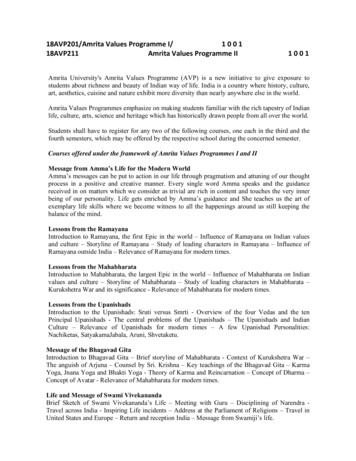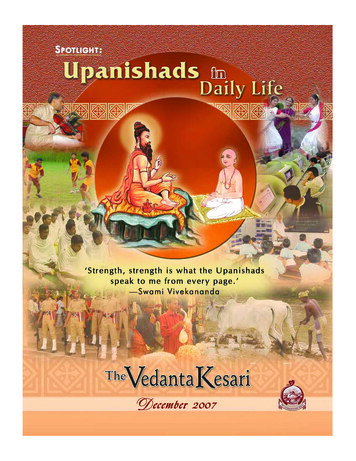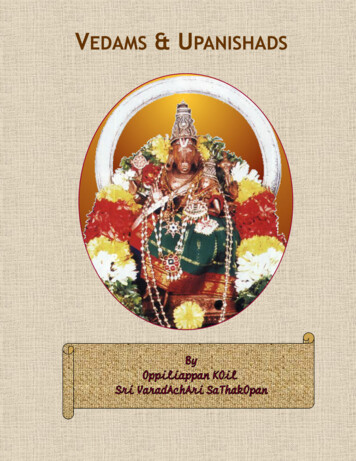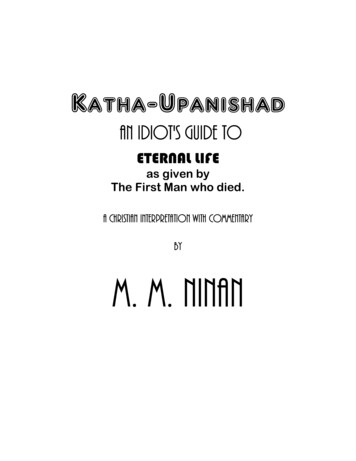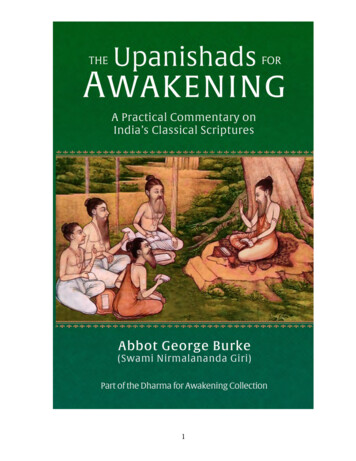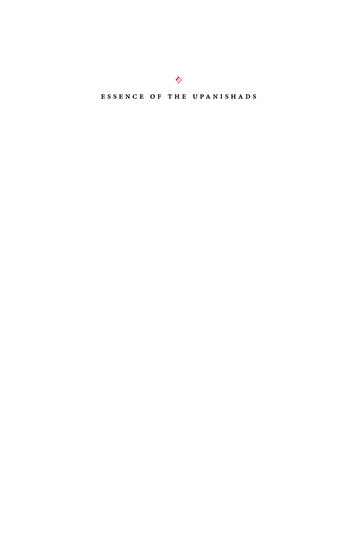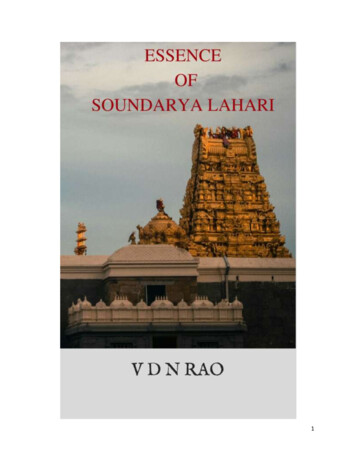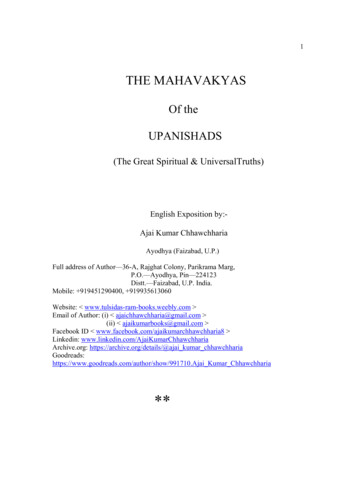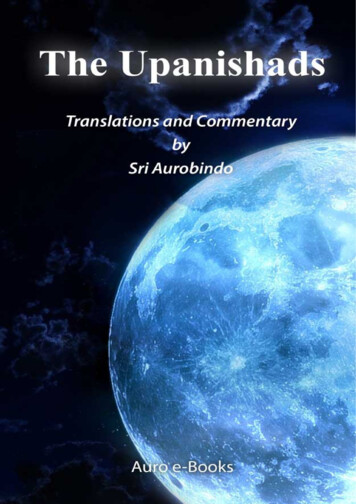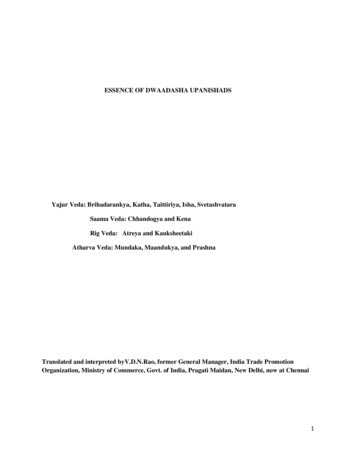
Transcription
ESSENCE OF DWAADASHA UPANISHADSYajur Veda: Brihadarankya, Katha, Taittiriya, Isha, SvetashvataraSaama Veda: Chhandogya and KenaRig Veda: Atreya and KauksheetakiAtharva Veda: Mundaka, Maandukya, and PrashnaTranslated and interpreted byV.D.N.Rao, former General Manager, India Trade PromotionOrganization, Ministry of Commerce, Govt. of India, Pragati Maidan, New Delhi, now at Chennai1
Other scripts by the same authorEssence of Puranas:Maha Bhagavata, Vishnu, Matsya, Kurma, Varaha, Vamana, Narada, Padma, Shiva, Skanda,Markandeya, Devi Bhagavata, Brahma, Brahma Vaivarta, Brahmanada, Agni, Bhavishya,Nilmata, and Shri Kamakshi Vilasa. Index of Main Subjects covered in Essence of Puranas toonotified.Dwadasha Divya Sahasra Naama:Chaturvidha Devi Sahasra Naama: Lakshmi, Lalitha, Sarasvati, GayatriChaturvidha Shiva Sahasra Naama: Shiva-Linga-Brahma Puranas and Maha BharataChaturvidha Vishnu Sahasra Naama: Padma-Skanda- Narada Puranas and Maha BharataStotra Kavacha- A Shield of PrayersPurana SaaraamshaSelect Stories from PuranasEssence of Dharma SindhuEssence Paraashara SmritiEssence of Pradhana TirthasEssence of Amarnath YatraEssence of Dharma BinduEssence of UpanishadsRig Veda Base: Kaushitaki*, AtreyaYayur Veda Base: Brihadarayanyaka, Katha, Taittiriya, Isha and Shvetsaavatara*Sama Veda Base: Chhandogya, KenaAtharvana Veda Base: Mundaka, Maandukya and Prashna[Note: All the above works already released vide kamakoti. org / news except those with * beingprocessed]2
FOREWORDVedas are constant flows from Chaturmukha Brahma, which are incessant, often complex andconfounding; only Seekers of standing could fathom the depths! Upanishads are perhaps the peripheralsthat Maharshis sougt to explain some outline skeches if not their the hidden messages!Of the hundreds of odd Upanishdads each standing out on its own luminosity are of an extraordinarysparkle. The more one dwelves, the deeper one on slips by! It is by the tight grip of the teeth that one isable to make out as an outline of each work of an Upanishad!It is perhaps not possible to assimilate even outside sketchs of various Upanishads at random. Humaneffort falls woefully far short of comprehension by the ordinary except those Mahatmas who are trulyblessed. Each Veda over flows an ocean and each such one ocean presents a singular thought all thesame! The message is common but interpretations are astouding. Perpelexity of Paramama is amazinglymystifying but essentially is quite direct and clean! ‘Antraatma’ is common to all; diverse yet identical. Itis you and you alone! But for aberrarions; it is too clean indeed but uncouth to the uncouth.This is thatenigma of existence. The body parts and senses lend colours. Mind is the colouring agent. Antartamawhich is Parmaatma, the reflection is ever pure and spotless.Almigty is amorphous, formlesss, and everlastimg. Chaturmkha Hiraygarbha is self generating.The bestpart of the Universe is yet unkown. Virat Purusha with the aid Prakriti or Maya is the face of theUniverse. The Lokas, Deva Daanavas or the forces of virtue and vice coexist with mutual interaction.This is what life all about; the eternal cycle of births and deaths ; it is finally perhaps concluded with theRealisation of The Truth!Some spills over of the reflection of Vedas are Brihadaranyka, Katha, Taittiraya, Isha, Svetahsvatara asrepesented by Yajurveda; Chhandogya and Kena represented by SaamaVeda; Kaushitaki and Atreyarepresented by Rig Veda; and Mundaka, Manduka and Prashna by Atharvana Veda. I salute Maha Swamithe legend of Kanchipura in whose memories that we in our familes abide by and cherish around thenucleus of Shri Lakshmi Kamakshi Nilaya in Chennai. He is the ever living Walking God in whom wetrust; indeed we trust. My squirrel like humble effort of ‘setu bandhana’ is dedicated unto HIM!VDN Rao and family3
ESSENCE OF BRIHADARANYAKA UPANISHAD4
PREFACEThe Essence of Brihadaranyaka Upanishad is an attempt in the series of the Essence of PradhanaUpanishads.The intention is provide the Sanskrit base and simple translation of meaning in English, without resortingto esoteric explanations and descriptive annotations. However the slant in the translation is within theframe work of Adi Shankara Bhashya, while various Schools of Thought for each of the Upanishads arein prevalence as per their own disciplines.It is stated that there are as many as 108 Upanishads as follows: 1) Mukhyopanishads viz. Brihadaranya,Katha, Taittiriya, Isha, and Svetaashvara all belongning to Yajur Veda; Chhandogya and Kena to SaamaVeda; Atreya and Kaushitaki to the Rig Veda School while Mundaka, Mandukya and Prashna are of theAtharvra Veda clan of Mukhya Upanishads; 2) Samanyopanishads: Atmabodha, Mudgala, Vajra soochi,Mahad, Savitri, Sarvasvata, Skanda, Shariraka, Ekaakshara, Akshi, Praanaagnihotra, Subala, Manitraka,Niraalamba, Pingala, Adhyatmika, Muktika, Surya, Atma Upanishads; 3) Sanyasopanishads: Nirvana,Aruneya, Maitreyani, Maitreya, Sanyasa, Kundika, Brahma, Garbha, Tejobindu, Avadhuta, Katha Rudra,Varaha, Jabala, Parama hamsa, Advaya taraka, Bhikshu, Turiyaatika, Yagnyavalkya, Satyayani, NaradaParivrajaka, Parama hamsa parivrajaka, Parabrahma, Tripura Upanishads; 4) Shaakteyopanishads:Tripuyra, Soubhagya, Bahvarcha, Saraswati Rahasya, Sita, Annapurana, Devi, Tripuraatapaani, BhavanaUpanidhads; 5) Vaishnavopanishads: Vaasudeva, Avyakta, Narayana, Kali santaarana, Taaraasaara,Narasimhataapani, Tripadvibhuti, Rama -rahasya, Ramaataapani, Gopaalataapani, Krishna, Hayagriva,Dattatreya, Garuda Upanishads; 6) Shaivopanishads: Akshamaalika, Rudraksha, Jaabala, Swetashvatara,Kaivalya, Kalagni Rudra, Dakshinamurti, Rudra hridaya, Pancha Brahma, Shira, Atharva shikha, BrihadJabala, Sharabha, Bhava, Ganapati; and 7) Yogopa -nishads:Nadabindu, Yogakundalini, Hamsa,Trishikhi, Mandala Brahmana, Shandilya, Paashupata, Maha Vakya and so on. The plan is to profile theMukhyopanishads in the Series of Essence of Pradhanopanishads as being planned.I am ever beholden to the benign blessings of HH Vijayendra Saraswati of Kanchi Mutt for his constantinspiration and spiritual guidance that he has bestowed on me in abundance. My grateful prostrations tohis grace for his continued blessings to me and all the members of my family.VDN RaoChennai5
CONTENTSPAGEPrefaceChapter One of Six Brahmanas:(i) Ashwamwedha Yagna (ii) Hiranyagarbha’s own body as the Sacrifice and the resultant Creation ofthe Universe (iii) Devasura Srishti and origin of ‘Udgeeta’ as a powerful medium to control Evil Forces;(iv) Prajapati’s ‘Ahamasmi’ or ‘I am Myself’ manifests Purusha and Prakriti - Creation of Beingsincluding Upadevas like Rudraadityas (v) Prajapati’s pair creates fathers, food, rituals, mind, speech and‘Praana’ (vi) Naama, Rupa, Karma -or Name, Form and Work- of Individual Self.Chapter Two of Six Brahmanas:(i) Ajatashatru- Balaki Gargya ‘samvaada’: step by step analysis of Brahman; Brahma Vidya; three Stagesof Awakenness- Dream- Death (ii) Origin of Human Beings with body parts and sensory organs as alsothe corresponding Sapta Rishis (iii) Mortal and Immortal ‘Swarupas’of Individual Selves and theSupreme (iv) Yagjnyavalkya-Maitreyi ‘samvada’detailing material resources vis-à-vis Salvation andUnity of Individual Self and Brahman (v) Madhu Vidya or the doctrine of honey as applicable to all theBeings, Elements, Concepts and the Self (vi) Madhu Vidya taught by Dadhyan Rishi to Ashwini Devatasassuming horse heads- the unique link between the Individual Self and the Supreme.Chapter Three of nine Brahmanas:(i) Madhu Kaanda Vamsha Teachers on Scriptural Authentication of the link between the Self and theSupreme (ii) Yagjnyavalkya-Ashwala wordy duel at Janaka’s horse sacrifice and the Maharshi declaredas the best of the Congregation of the Learned since human bondage by ‘Grahas’ and ‘Atigrahas’controlling the Organs would end by death and subsequent transmigration of the Souls takes place asdecided by the ‘Paapa-Punya’ accounts (iii) Supremacy of Horse Sacrifice performed by Gandharvas andextra territorial Beings too for Salvation - Yagjnyavalkya- Gandharva ‘samvaada’ on Cosmic Vital Force(iv) Gross body perishes and opens a fresh account of Karma Phala while Subtle Body lasts for ever asevidenced by ‘Praana’ or ‘Vayu’the ever present (v) Equation of Antaratma and Paramatma logicallyleads to quest for Brahman by means of renunciation (vi) Pursuit beyond the warf and woof of the clothof Creation, Nature and Universe (vii) ‘Sutra’ or the thread between Brahman and the Self is Vayu-thesubtle entity connecting the Five Elements, body organs and senses, praana and the past-present-future,but none realises the link except Brahman himself! (viii) The Sutra is the connector to the two halves ofthe Cosmic Shell while the process of ‘neti neti’ or ‘not this not this’ leads to Ultimate Reality! (ix)Yagjnyavalkya-Shakalya samvada about the worship worthy Devas viz. Rudras, Adityas,Vasus, Indraand Prajapati, besides Matter, Vital Force and so on!6
Chapter Four of six Brahmanas:(i) Refinement of the concept of Brahman: Speech,Vision, Hearing, Mind and Heart (ii) Gross, Subtle,Causal bodies of Self-Supreme in explicit and implicit forms (iii) Janaka- Yagjnyavalkya’s deep sessionon proven Identity of Self-Supreme entities as these are mutual reflections ; Identity of Self- Supremedespite the former’s awaken and dream change over stages (iv) Mortal life’s final stage described ascaterpillar reaches the edge of grass and holds another grass for support (v) Yagjnyavalkya-Maitreyisamvada on Causative fullness to derivative causation in view of the cause and effect syndrome (vi) Thetradition of Guru-Sishya.Chapter Five of fifteen Brahmanas:(i) ‘Purnamada, Purnamidam, Purnaat purnamudacyate’: This and that are Full ; from fullness is derivedfullness and even if fullness is exhausted, still fullness prevails for ever! In other words, causative fullnessis derivative causation; that is the Cause and Effect Syndrome (ii) Damayita-Daana-Daya or ControlCharity- Compassion constitute the three seeds of Virtue (iii) Prajapati’s heart or ‘hri-da-ya’ acts withqualities of Ushering- Giving-Securing which direct a human being’s name-form-work (iv) PrajapatiBrahman’s hridaya is also the seat of Intellect as the varied appearance of Truth highlighting the Grossand Subtle Forms of Brahman as True, Absolute, Real, and Magnificent! (v)Satya Brahman manifests asWater, Surya and ‘Bhurbhuvaswah’(vi) Mind is the key indicator of Reality and Falsity as Yogis subdueit and sift the Truth and Untruth (vii) Vidyut Brahman or lightnings flashing darkness and highlightingParamatma (viii) Vaak Brahman focusses speech connoting Vedas ans Scriptures declaring loud aboutTruth and Untruth (ix) Vishwaanara Agni Brahman proclaims his splendour and clearly distinguish Truthand Untruth (x) Vaayu Brahma or Praana deva demonstrates his prowess by his ready presence or absenceand segregate Truth and Untruth (xi) Austerities like fasting and detachment embolden to face deathseeking better status in the life ahead! (xii) Seekers of Brahman do realise the role of food and praana asinevitable factors of existence for seeking better comfort subsequently! (xiii) Meditation to Praana byUkta Geeta facilitates unification of the body and the Soul!(xiv) Gayatri’s worship unifies Praana withAgni to burn off body pollutions and heaps of sins and heralds new pastures (xv) Prayerse to Surya Deva,Agni and Vayu to lead to Brahman / Self indeed.Chapter Six of five Brahmanas:(i) Vasishathatva or Superiority of Praana over all the body organs and their corresponding faculties (ii)Panchala King Pravahana and Gautama Samvada on the travel pattern of a Good Soul after death, and asper Karma Phala enter the smoke zone of ether and travel to Pitru-Chandraadi lokas and after enjoying thecompany of Devas as stipulated by time return back to earth through ether/ rain as destined as a plant orinsect or animal or a human again (iii) The methodology of Agni Karya by offering Sacrificial ‘Mantha’or paste of fig wood and herbs/grains with devotion and faith by accompanying Mantras; the oblations areoffered to Agni Deva targetting Prajapati, Surya, Chandra, Praana Deva etc.(iv) Procreation duties of manand woman on the pattern of a Yagna with Fire, Wood, and similar Tools and the ceremonies that followon the arrival of the child! (v) Line of Teachers and Students traced back to Prajapati and SwayambhuBrahma Himself!7
ESSENCE OF BRIHADARANYAKA UPANISHADOm Purnamadah purnamidam Purnaatpurnamudachyute, Purnasya purnamaadaaya purnamevaavashyate/ Om Shantih Shantih Shantih! ( Paramatma is infinite and eternal, and this Universe is infinite.This infinite Univerese is totally dependent on Paramatma; Thus the Infinity of the Universe leads to theother Infinity plus viz. Eternity leads the Original Infinity forever; Let there be Peace in the Universe,Peace in the Universe and Peace again in the Universe as to be ushered by Paramatma ---------------------------Ashwamedha YagnyaI.i.1) Om/ Ushaa vaa ashwasya medhyasya shirah, Suruyaschakshuh Vaatah Praanah Vyaattaragnirvaishwaanarah Samvatsara Atmaashwasya medhasya/ Dyouh prishtham Antarikshamudaram Prithivipaajasyam Dishah paarshve Avaantardishah parshwah Rutavongaani Maasaashrthamaasascha parvaaniahoraatraani pratishthaah nakshatraanyasthaanaani Nabho maamsaani/ Uvadhyam sikataah sindhavogudaah yakruccha klomaanascha parvataah Aoushadhyascha vanaspatayascha lomaani udyanpurvaarthah, oshadhayascha vanaspatayascha lomaani,udyan purvaardhah nimlochan jaghanaardhah,yad vijrumbhate tad vidyotate, yad vidhunute tat stanayati yanmehati tad vasshati; vag evasyavaak/ (Om,while comparing an Ashwamedha or Horse Sacrifice to Nature, then Ushahkaala or the early dawn iscomparable to its head, its breathing or life-force as Air, its eyes like Surya, its open mouth as Agni/ Fireor Vaishwanara and the body of the ‘Ashwa’ as comparable to a Year or better still the ‘Kaalamaana’orthe Time Cycle; its back as ‘Swarga’; its belly like sky; its hoof like Earth; its sides like one fourths of ayear; its limbs like the Seasons of a Year; its body bone joints like months and fortnights; its hooves likedays and nights; its bones like Nakshatras or Stars; and its flesh like clouds. The Sacrificial horse’s foodin the stomach is like sand, its blood vesssels are rivers, liver and spleen are comparable to mountains andthe hairs like herbs and tree. The rising Surya is the horse’s forepart while the hind part like the Sun set.The horse’s yawns are comparable to lightings and its body shakes and shrieks are like thunders; itsurination is like downpour rainfall and neighing is like sound waves!) (I.i.2) Aharvaa ashvam purastaanmahimaanvajaayata tasya purve samudre yonih, Ratriryenam paschan mahimaanvajaayata tasyaapare;Samudrayonih etauvaa ashwam mahimaananavabhitah samvabhuvatuh, Hayo bhutwaa Devaan avahatvaaji gandharvaan arvaasuraan ashvo manushyaan samudra evasya bandhuh samudro yonih/ ( Thedawn arises as the Swarna Kumbha or golden vessel -‘Dipti Samanyat’-Mahiman appears in front of theSacrificial Horse pointing out the day ahead and its origin is the Eastern Sea; at the dusk time or theevening the the Rajata Kumbha or the Silver Vessel is kept on the rear side of the horse pointing to thearrival of night; its source is the Western Sea. These two sacrificial vessels are kept on the front and rearsides of the Sacrificial Horse thus indicating the dawn and dusk. The context differs in respect of HorseSacrifice: it is called Haya Medha in respect of Devas, Vaajina Medha for Gandharvas, Arva Medha forAsuras and Ashwa Medha for human beings. Indeed, Sea is the common relative for Devas, Gandharvas,Asuras and human beings alike!)8
( This is the end of the First Brahmana)Hiranyagabha’s own body as the Sacrifice and the resultant Creation of UniverseI.ii.1) Naiveha kimchanaagra aseet,Mrityunaivedaamaavritamaaseet, Ashanaayaya, Ashanaayaaya himrityu;, tanmano -kuruta, Atmanvi syaamiti, Sorchannacharat, tasyaarchata aapojaayanata archate vaime kam abhud iti; tad evaarkasya arkatwam; kam ha vaa asmaibhavati, ya evam etaad arkasyaarkatwam veda/ (Since nothing at all existed at the very start, except Mrityu or Death renamed as hunger,Bhagavan Hiranyagarbha materialised Consciousness or Mind and in the thought process of concentrationthere emerged water and its synonim viz. happiness and eventually ‘Arka’ or Fire) (I.ii.2) Apo vaa Arkahtadyad apaam shara aseet, tat samahyanta, sa prithivi abhavat, tasyaam ashraamyat, tasya shraantasyataptasya tejo raso nirvartataagniih/ (While Arka is water, its froth got solidified as Bhumi / Earth, onwhich Bhagavan rested and warmed up by further cogitation and the concentration became bright andthus Agni or Fire got materialised). (I.ii.3) Sa tredhatmaanam vyakuruta, Adityam triteeyam, Vayumtriteeyam; sa esha pranastredhaa vihitah, Tasya prachi dik shirah,asau chaasou chaimo, athaasyaprachiti dik puccham, Asou chaasou chermoucha shakthyau;dakshinaa chodichi cha parshve, dhyouhprushtham, antarikshmudaram, iyam urah, sayesopusu pratishthitah, yatra kva chaiti tadevapratishthatevam vidwaan/ (Bhagavan differntiated himself into three parts, as Agni, Surya and Vayu. TheViraja Bhagavan or Life Force viz. Praana is in three directions viz. head as the East, his hands as northeast and south east, his rear portion as the west, his hip bones as north west, southern and northerndirections as his side portions, Sky as the ‘udaram’ or stomach; and Earth as his chest. The Almighty restscosily on sheets of water. Those who realise the above facts would indeed become aware of where Heresides!) (I.ii.4) Sokaamayata, dwiteyo ma Atmaa jayeteti, sa manasaa vaacham mithunam sambhavadashanaayaa Mrityuh; tad yat retaa asheetsa samvatsaro bhavat, naha puraa tatah samvatsaraaasa;tametaavantam kaalamavibhah, yaaaansamvatsarah, tam etaavatah,kaalasya parastaadam asrijat/Tam jaatamabhivyaadadaat, sabhaanakarot,saiva vaagbhavat/ ( Bhagavan decided to manifest himself inan alternate form : along with the interaction of death and hunger, he desired to create another form ofexistence which created ‘Kaalamaana’ or Time Measurement in the denomination of Samvatsara or aYear. Death reared the babe named the Year but after this duration opened its jaws and mouth to devourthe babe; the latter out of sheer fright cried and the shrieks thus created ‘bhaan’ and indeed that sound ofdistress led to the creation of speech). (I.ii.5) Sa aikshata yadi vaa imamabhimasye, kaniyonnam karishyaiti sa tayaa vaachaa tenaatmanedam sarvam ashrajata yad idam kim cha, richo yajushi saamaanicchanadaamsi yagjaan prajaah pashun, sayadyaddevaasrujata tat tad attum adhriyata; sarvam vaa attititadaditer adititwam; sarvasaitasyaattaa bhavati, sarvam asyaannam bhavati, ya evam etadaditeratititwam Veda/ ( He pondered that if the baby were to be killed then it might not serve any purpose; onthe other hand, with the help of speech since now created might be useful to develop hymns of Rig Veda,the formule of Yajur Veda, the chantings of Sama Veda, the meters of Chando Shastra comprising theSeven meters like Gayari, details of Sacrifices like Ashwamedha Yagna, as also create men and animals.Moreover, he resolved to eat the food available, and for that matter he would eat any kind of palatablefood of Aditi type for whom every thing would become food for him.) (I.ii.6) Sokaama -yata bhuyasayagnena bhuyo yajeyati; so shraamyat, sa tapotapyata: tasya shranatasya taptasya yashoveeryamudukraamat, praana vai yasho veeryam;tatpraneshutkranteshu shariram shayutum adhriyatatasya sharira eva mana aseet/ (He then resolved to execute a Great Sacrifice; he meditated and rested fora while, pracising rigorous Tapasya or austerity; even as he relaxed and concentrated, his distinction andgreat renown got envigorated. Indeed, his body showed symptoms of fatigue and swelling as the extreme9
naure of Tapasya was like ‘tapotapyata’ or of burning extremity). (I.ii.7) So kamayata, medhyam ma idamsyaat, atmanvi anena syamiti, tatoshvah samabhavat yadashwat, tan madhyemabhuditi, tadevaashvame dhavsyaa medhatvam, yesha ha vaa ashwamedham vedaya yanmevam veda, tam anavarudhyaivaamanyata, tam samvatsarasya parastaad atmana aalabhata, pashun Devataabhyah pratyouhat,tasmaatsarva Devatyam prikshitam Praajaapatyam alabhante; esha ha vaa Ashwamedho ya esha tapati:tasya samvatsara aatmaa, Ayam Agnir Arakah, tasyame lokaa atmanah; taavetaavaarkaashvamedhou/So punarekaiva Devataa bhavati mrityureva; apa punarmrityum jayati, nainam mrityuraapnotimrityurasyatmaa bhavati, etaasaam Devataamaneko bhavati/ (Hiranyagarbha Bhagavan decided tosacrifice his body and thus materialised a Horse and decided to perform Ashwa medha Yagna; indeedwhoever realises the implication of the Great Sacrifice is thus aware of Ashwamedha. Imagining himselfas the Sacrificial Horse, he let it free for a year and allowed it to be sacrificed; thus till date, the priestsperforming the horse sacrifice do realise the implication that Bhagavan Hiranyagarbha himself issacrificed in the Arka or Fire and his own limbs are dedicated to Devas for ‘Loka Kalyan’ or forUniversal Well Being. Those who do realise this hidden implication conqures Mrityu / death since deathcan never ever overtake him and becomes the Great Self Himself!) In retrospective of this Chapter, onewould appreciate that Hiranyagarbha’s own body parts like head, hands, stomach and so on are theUniverse in totality)!(This is the end of the Second Brahmana)Devaasura Srishti and origin of ‘Udgeeta’ as a powerful medium to control Evil Forces( I.iii.1) Dwayaaha Praajaapatyaah Deveshcha-asuraaschya tatahkaaniyasaa eva Devaah jyaayasaaasuraah; ta eshu lokeshwaspardhant; te ha Devaa uchyuh hantaasuraanyagjna udgithenatyayaameti/(The descendants of Prajapati Brahma are classified as Devas and Asuras and while the former are few innumber and younger in age, Asuras are larger and older. They vie with each other for Supremacy overeach other. Then Devas decided in mutual agreement to dominate in the Lokas by way of performingSacrifices viz. Jyotishtoma through ‘Udgitha’ or through identity with Vital Energy as prescribed inScriptures delivered by Brahma himself and as per the repetition of the relevant Mantras). ( I.iii.2) Te havaacham uchuh, twam na udgaaya iti tatheti, tebhyo vaag udgaayat, yo vaachi bhogastam Devebhyaaagaayat,yat kalyaanam vadati tadaatmane, te viduranena vai na Udgaatraatyeshyanteeti tamabhidrutya paapmaana –avidhyan; sa yah sa paapmaa, yade vedamapratirupam vadati sa eva sapaapmaa/ (Devas decided that the speech and correct pronounciation and chanting with intonation inUdgitha is the most essential aspect of the Mantras and Asuras too are well aware that precision in thisrespect would be excelled by Devas; the rest of the Yagna is meditation and ‘karmaacharana’ or theexcution of the work involved in the worship which Asuras too might perform as well. Hence Devasmutually resolved to control the tongue and text of the Mantras with extreme perfection. Any slip of theUdgitha could pierce with evil and hence the extra caution!) (I.iii.3) Atha ha praaam uchuh, twaamnaUgyaata iti, tebhya praana udagaayat, Yah praane bhogasstam Devebhya aagaayat,yat kalyaanamjighnati tadaatmane, Tey viduranena vai na udgaatraatyepyanteeti tamabhidhrutya paapmanaa -vidhyan;sa yah sa paapmaa, yadevedamapratirupam jighnati sa yeva paapmaa/ (Then Devas asked Praana tochant Udgata, then the nose responded and whatever happiness is possible for the Devatas was enjoyed bythem by the chanting; Asuras no doubt knew well that when udgata is rendered by the nose it wouldindeed be perfect, yet they tried to spoil by evil smells which were improper) (I. iii.4) Atha hachakshuruchuh,twam na udgaayeti,tayeti tebhyaschakshurudagaayat, yaschakshushi bhogastam10
Devebhya aagaayat, yatkalyaanam pashyati tadatmane, te viduranena vai na udgaatraatresshyanteeti,tamabhidrutya paapmanaavidhyan, sa yah sa paapmaa, yadevedamapratirupam pashyati sa eva sapapmaa/ (Devas asked the eyes to chant Udgata for them and the eyes responded likewise and Devasenjoyed the sastisfied looks of the chanters, while Asuras too were aware that the looks of the chanters yettried to distract their looks from evil sources.) (I.iii.5) Atha ha shrotramuchuh, twam na udgaayeti;tebhyah shrota muda gaayat; yah shrotre bhogasta Devebhya aagaayat, yat kalyaanam shrunutetitadaatmane, tey viduranena vai na udgaatraatyepyanteeti, tamabhidrutya paapmanavindhyan; sa yah sapaapmaa, yadevedamaprati rupam shrunuteti sa eva sa paapmaa/ ( Devas enquired of the ears to chantUdgita and they readily responded as Devas were thrilled at the cadence and rhythm of the sonorouschanting, even as Asuras while fully knowing the ideal rendering still tried to divert the attention of thechanters and failed) (I. iii.6) Atha ha man uchuhu, twam na udgaayeti; tatheti tebhyo mana udgaayat; yomanasi bhogastam Devebhya aagaayat,tatkalyanam sankalpayati tadatmane, tey viduranena vai naudgaatraatepyayanteeti, tamabhidrutya paapmamnaa vindhyan; sa yah paapmaa yadevedamapratirupamsankalpayati sa eva sa paapmaa, evam khalvetaa Devataah paapmabhi rupaa -srujan, evamenaahpaapmanaa vindyan/ ( Devas consulted the minds of the Udgita chanters and as they obliged with thechanting as their minds were so clean that Devas had no bound of joy and the minds were not waveringexcept the concentration on the chanting; the Devils wondered at the purity of the minds of the chantersbut still tried their utmost to distract the attention but could not) (I.iii.7) Atha hemamaanasanyampraanamuchuh, twam na udgaayeti,tatheti, tebhya eshapraana udgaayat; te viduranena vai naudyagatraatyeshanteeti, tamabhidrutya paamnaavidhyayan.; sa yathaashmaanmrutwaa loshtovidhvamset, evam haiva vidhwamsamaanaa vishvancho vineshuh, tato Devaa abhavan paraasuraah,bhavatyatmaanaa, parsaya dwishanbhratuvyo bhavati ya evam Veda/ (Devas also enquired of the VitalForce in throat to chant the Udgita for them and the priests readily agreed and rendered it which was setto perfect rhythm and tempo ; it was so attractive that despite the disturbances by demons, it wasexraordinary and the evil images by Demons failed to get Devas distracted; in fact like a piece of Earthgets crushed by the onslaught of rocks the evil influences by Asuras got crushed and perished). (I.iii.8) Tehochuuh kva nu sobhuudyo na ityamasakteti; ayamaasyentriti; soyaasya Aangirasah angaanaam hirasah/(When asked as to who was the chief promoter that sustained their divinity they realised that thevitality of the mouth of the chanters called Ayaasya Angirasa, the essence of the body parts is ofsignificance. Indeed, one’s own Self with perfect intentions and firm resolve could withstand all kinds ofevil powers); (I.iii.9) Sa vaa eshaa Devataa durnamaa, duram hi asyaa mrityuh; Duuram ha vaa asmaanMrityuh; Duram ha vaa asmaan mrityurbhavati ya evam Vedaa/ ( The Deity named ‘Duur’ is whatresisted the evil energies sought by the Asuras and this Deity is a perfect antithesis of the evil efforts andfar from Mrityu /Death too.) ( I.iii.10) Saa vaa esha Daivataasaam Devataanaam paapmaanam mrityumapahatya, yatraasaam dishaam antah tad gamyaam chakaara tad aashaam paapmano vinya dadhat,tasmaan na jaanam iyaat, naantam iyat, net paapmaanam mrityum anvaayaaneeti/ (Indeed that Deity isintolerant of evil from any source, even inclusive of Devas, and would go any far till its logical end; oneshould never ever enter that territory of no return by any body since that borders on Mrityu or Death andtotal destruction!) (I.iii.11) Sa vaa eshaa Devataitaasaam Devataanaa paapmaanam Mrityumapahathyaarathainaa Mrityumapatyavahat/ (This unique Deity after destroying death as also even the negativeinfluences of Devas would liberate far beyond the realms of death) (I.iii.12) Sa vai vaachamevaprathamaam atyavahat; saa yadaa mrityumatyamuchyat sognirabhavat; soyamahnih parenamrityumatikraanto deepyate/( This Deity carries the organ of speech and once speech is freed from deaththen at that stage turns into Agni Deva) (I.iii.13) Atha paanamayavahat; sa yadaamrityumatyamucchayat11
sa Vaayurbhavat; soyam Vaayuh parena mrityumati -kraantah pavate/( The Deity called ‘Duur’resistsimperfections of another body organ viz. nose and once all the impurities of nose are cleared of the fear ofdeath or destruction, then that stage is stated to materialise Air or Vayu Deva.) ( I.iii.14) Athachakshuratya vahat,tadyadaa Mrityumatya -muchyayat sa Adityobhavat; sosvadityah parena Mrityumati-krantastapati/ (The Deity then purifies the eyes and the vision of death when that stage leads to Surya theepitome of high luminosity!) ( I.iii.15) Atha shrotramatyavahat; tadyatadaa mrityumatyamucchat taadishobhavan taa imaa dishah parena mrityumatikrantaah/ ( The Deity then purifies the ears and thethreat of death in a person when those territories cross beyond all limits); ( I.iii.16) Atha manotyavahat;tadyadaa mrityumatyamucchayat sa Chandramaa abhavat; sosou Chandrah parena mrityumatikraantobhati; evam ha vaa enmeshaa Devataa mrityumativahati ya emam Vedaa/ (The Deity then carried themind whose aberrations and impurities are cleared and also overcome by the fear of death). (I.iii.17) Athaatmanennaadyamaagaayat; yaddhi kimchaannam adyate anenaiva tad yadyate, iha pratishthati/ (Thenthe organ of speech and its origin viz. throat and tongue yearned for and chanted of food and whatever isconsumed is converted as its essence in the form of the life force). ( I. iii.18) Te Devaa abruvan etaavadvaa idam sarvam yad annam tadaatman aagaaseeh, anunosmin annan aabhajasviti, te vai maabhisamvishteti, tatheti: tam samantam parinyavishant, tasmaadyanenaannam atti, tenaitastrupyanti, ye havaa yenam swaa abhishanvishanti, bhartaa swaanam sheshthah pura yetaa bhavatyannaadodhi
frame work of Adi Shankara Bhashya, while various Schools of Thought for each of the Upanishads are in prevalence as per their own disciplines. It is stated that there are as many as 108 Upanishads as follows: 1) Mukhyopanishads viz. Brihadaranya, Katha, Taittiriya, Isha, and Svetaashvara all belongning to Yajur Veda; Chhandogya and Kena to Saama
